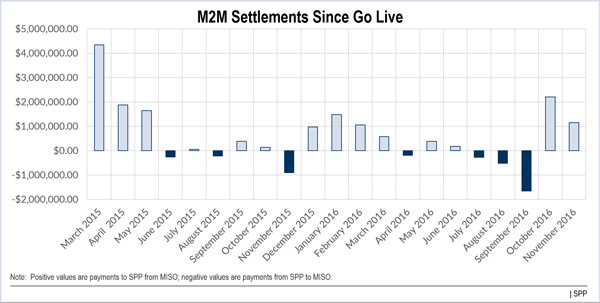SPP set several new records for wind generation last week, lending further credence to its claims that it can handle wind-penetration levels as high as 75%.
Wind resources peaked at 13,587 MW at 7:55 a.m. on Dec. 4 and then again at 14,150 MW at 9:55 p.m., bettering the old record of 13,342 MW, set on Feb. 9.
SPP also set new standards for wind penetration (56.25%) and renewable energy penetration (58.23%) Dec. 4. Coal accounted for 28.94% of the energy produced at that time and gas for 11.58%.
The RTO has nearly 18 GW of wind capacity in service and almost 44 GW of additional capacity in all stages of development. Staff said earlier this year it could serve up to 75% of its load with wind energy and other renewable resources. (See SPP Eyes 75% Wind Penetration Levels.)
SPP in February became the first North American RTO to produce more than 50% of its energy from wind resources. (See SPP First RTO to 50% Wind Energy Penetration Level.)
Staff to Meet with FERC on Rejected Seams Project
SPP staff told the Seams Steering Committee (SSC) last week they plan to meet with FERC staff in January to resolve a seams project recently rejected by the commission.
FERC in October nixed SPP’s proposal for regionwide/load-ratio share funding for its portion of two projects with Associated Electric Cooperative Inc. (AECI) and City Utilities of Springfield, Mo. The commission ruled SPP had not shown they were “roughly commensurate with the projects’ benefits.” (See FERC Rejects Cost Allocation for SPP-AECI Seams Project.)
SPP Interregional Coordinator Adam Bell said staff would perform additional analysis on the AECI project before meeting with commission staff. SPP and AECI agreed to build a new 345/161-kV transformer at AECI’s Morgan Substation and uprate an existing transmission line, with the RTO covering $17.1 million of the $18.75 million cost.
“Once we have direction from that meeting, we’ll come back and make a decision on the best way forward,” he said.
A second seams project with City Utilities, the installation of a new 345-kV 50-MVAR reactor at the city’s Brookline substation that was also rejected by FERC, has been included in the 2018 Integrated Transmission Planning Near-Term (ITPNT) assessment.
SPP and AECI are meeting Dec. 20 to discuss a joint and coordinated system planning study. Under terms of their joint operating agreement, the two systems are to conduct such a study every other year.
Bell said the study scopes have varied in the past, from “full-blown joint models to participating in a study SPP is already doing.”
MISO Incurs $5M Hit on Single M2M Flowgate
MISO is on the hook for $6.1 million in market-to-market (M2M) payments to SPP for October, the largest bill in the 32 months since the two grid operators began the coordination process.
A single flowgate in the Empire District and Westar Energy control zones that was binding for 329 hours in October was responsible for $5.1 million alone. SPP said high wind flows from MISO and local outages made the flowgate difficult to control.
Several stakeholders expressed confusion as to why MISO is not taking steps to resolve the situation on its side of the seam.
“MISO has not come to us and suggested we consider any joint transmission projects to mitigate the congestion,” said David Kelley, SPP’s director of interregional relations. “If it was us, we would go to them.”
Asked for comment, MISO spokesman Mark Brown responded, “As part of MISO’s ongoing planning process, we regularly evaluate historic congestion and assess feasible ways to address those issues.”
Through October, MISO has paid $27.7 million to SPP. The two RTOs began the M2M process in March 2015.
— Tom Kleckner





